Related Research Articles
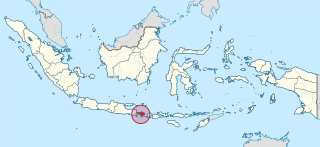
Bali is a province of Indonesia and the westernmost of the Lesser Sunda Islands. East of Java and west of Lombok, the province includes the island of Bali and a few smaller offshore islands, notably Nusa Penida, Nusa Lembongan, and Nusa Ceningan to the southeast. The provincial capital, Denpasar, is the most populous city in the Lesser Sunda Islands and the second-largest, after Makassar, in Eastern Indonesia. The upland town of Ubud in Greater Denpasar is considered Bali's cultural centre. The province is Indonesia's main tourist destination, with a significant rise in tourism since the 1980s. Tourism-related business makes up 80% of its economy.

Trance and Dance in Bali is a short documentary film shot by the anthropologists Margaret Mead and Gregory Bateson during their research on Bali in the 1930s. It shows female dancers with sharp kris daggers dancing in trance, eventually stabbing themselves without injury. The film was not released until 1951. It has attracted praise from later anthropologists for its pioneering achievement, and criticism for its focus on the performance, omitting relevant details such as the conversation of the dancers.

A ritual is a sequence of activities involving gestures, words, actions, or revered objects. Rituals may be prescribed by the traditions of a community, including a religious community. Rituals are characterized, but not defined, by formalism, traditionalism, invariance, rule-governance, sacral symbolism, and performance.

Gregory Bateson was an English anthropologist, social scientist, linguist, visual anthropologist, semiotician, and cyberneticist whose work intersected that of many other fields. His writings include Steps to an Ecology of Mind (1972) and Mind and Nature (1979).

Balinese Hinduism is the form of Hinduism practised by the majority of the population of Bali. This is particularly associated with the Balinese people residing on the island, and represents a distinct form of Hindu worship incorporating local animism, ancestor worship or Pitru Paksha, and reverence for Buddhist saints or Bodhisattava.
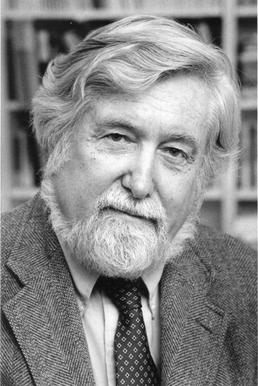
Clifford James Geertz was an American anthropologist who is remembered mostly for his strong support for and influence on the practice of symbolic anthropology and who was considered "for three decades... the single most influential cultural anthropologist in the United States." He served until his death as professor emeritus at the Institute for Advanced Study, Princeton.

The Balinese people are an Austronesian ethnic group native to the Indonesian island of Bali. The Balinese population of 4.2 million live mostly on the island of Bali, making up 89% of the island's population. There are also significant populations on the island of Lombok and in the easternmost regions of Java.

Thomas Albert Sebeok was a Hungarian-born American polymath, semiotician, and linguist. As one of the founders of the biosemiotics field, he studied non-human and cross-species signaling and communication. He is also known for his work in the development of long-time nuclear waste warning messages, in which he worked with the Human Interference Task Force to create methods for keeping the inhabitants of Earth away from buried nuclear waste that will still be hazardous 10,000 or more years in the future.

Hinduism in Indonesia, as of the 2018 census, is practised by about 1.74% of the total population, and almost 87% of the population in Bali. Hinduism was the dominant religion in the country before the arrival of Islam and is one of the six official religions of Indonesia today. Hinduism came to Indonesia in the 1st-century through Indian traders, sailors, scholars and priests. A syncretic fusion of pre-existing Javanese folk religion, culture and Hindu ideas, that from the 6th-century also synthesized Buddhist ideas as well, evolved as the Indonesian version of Hinduism. These ideas continued to develop during the Srivijaya and Majapahit empires. About 1400 CE, these kingdoms were introduced to Islam from coast-based Muslim traders, and thereafter Hinduism, which was previously the dominant religion in the region, mostly vanished from many of the islands of Indonesia.
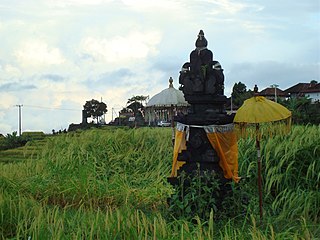
Subak is the water management (irrigation) system for the paddy fields on Bali island, Indonesia. It was developed in the 9th century. For the Balinese, irrigation is not simply providing water for the plant's roots, but water is used to construct a complex, pulsed artificial ecosystem. The system consists of five terraced rice fields and water temples covering nearly 20,000 hectares. The temples are the main focus of this cooperative water management, known as subak.
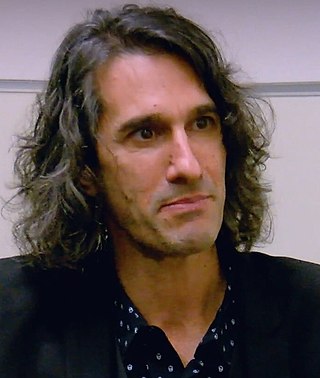
Agustín Fuentes is an American primatologist and biological anthropologist at Princeton University and formerly the chair of the Department of Anthropology at the University of Notre Dame. His work focuses largely on human and non-human primate interaction, pathogen transfer, communication, cooperation, and human social evolution.

Tirta Gangga is a former royal palace in eastern Bali, Indonesia, about 5 kilometres from Karangasem, near Abang. Named after the sacred river Ganges in Hinduism, it is noted for the Karangasem royal water palace, bathing pools and its Patirthan temple. The one hectare complex was built in 1946 by the late King of Karangsem but was destroyed almost entirely by the eruption of nearby Mount Agung in 1963.
In political anthropology, a theatre state is a political state directed towards the performance of drama and ritual rather than towards more conventional ends such as warfare and welfare. Power in a theatre state is exercised through spectacle. The term, coined by Clifford Geertz (1926–2006) in 1980 in reference to political practice in the nineteenth-century Balinese Negara, has since expanded in usage. Hunik Kwon and Byung-Ho Chung, for example, regard contemporary North Korea as a theatre state. In Geertz's original usage, the concept of the theatre state contests the notion that precolonial society can be analysed in the conventional discourse of Oriental despotism.
The 1917 Bali earthquake occurred at 06:50 local time on 21 January. It had an estimated magnitude of 6.6 on the surface wave magnitude scale and had a maximum perceived intensity of IX (Violent) on the Mercalli intensity scale. It caused widespread damage across Bali, particularly in the south of the island. It triggered many landslides, which caused 80% of the 1,500 casualties.
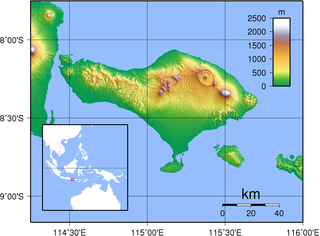
Negara: The Theatre State in Nineteenth-Century Bali is a 1980 book written by anthropologist Clifford Geertz. Geertz argues that the pre-colonial Balinese state was not a "hydraulic bureaucracy" nor an oriental despotism, but rather, an organized spectacle. The noble rulers of the island were less interested in administering the lives of the Balinese than in dramatizing their rank and hence political superiority through large public rituals and ceremonies. These cultural processes did not support the state, he argues, but were the state.
It is perhaps most clear in what was, after all, the master image of political life: kingship. The whole of the negara - court life, the traditions that organized it, the extractions that supported it, the privileges that accompanied it - was essentially directed toward defining what power was; and what power was what kings were. Particular kings came and went, 'poor passing facts' anonymized in titles, immobilized in ritual, and annihilated in bonfires. But what they represented, the model-and-copy conception of order, remained unaltered, at least over the period we know much about. The driving aim of higher politics was to construct a state by constructing a king. The more consummate the king, the more exemplary the centre. The more exemplary the centre, the more actual the realm.

J. Stephen Lansing is an American anthropologist and complexity scientist. He is especially known from his decades of research on the emergent properties of human-environmental interactions in Bali, Borneo and the Malay Archipelago; social-ecological modeling, and complex adaptive systems. He is an external professor at the Santa Fe Institute and the Complexity Science Hub Vienna; a Fellow at the Center for Advanced Study in the Behavioral Sciences at Stanford; a visiting scholar at the Hoffman Global Institute for Business and Society at INSEAD Singapore, and emeritus professor of anthropology at the University of Arizona.
Linda Helen Connor is an Australian anthropologist. She is Emeritus Professor of Anthropology at the University of Sydney.

Stephen Fuchs was an Austrian Catholic priest, missionary, and anthropologist who researched the ethnology and prehistory of India. After obtaining a Ph.D. in ethnology and Indology from the University of Vienna in 1950, Fuchs moved to India where he assisted in founding the Department of Anthropology at St. Xavier's College in Bombay. After a brief imprisonment for being misidentified as a German missionary by the British government during World War II, Fuchs founded the Indian Branch of the Anthropos Institute, later renamed the Institute of Indian Culture. Fuchs, because of health concerns, moved to Austria in 1996 and died at the age of 91 in Mödling, Austria.
Makata Pangkaja was a Balinese king from the Warmadewa dynasty.
Hildred Storey Geertz was an American anthropologist who studied Balinese and Javanese kinship practices and Balinese art in Indonesia.
References
- ↑ Heider, Karl G. (2008). "Perfect Order: Recognizing Complexity in Bali. By J. Stephen Lansing. Princeton, N.J.: Princeton University Press, 2006. Xii, 225 $37.95 (cloth)". The Journal of Asian Studies. 67 (2). doi:10.1017/S0021911808001095. JSTOR 20203416. S2CID 162212888.
- ↑ Johnsen, Scott A. (2009). "Perfect Order: Recognizing Complexity in Bali". The Australian Journal of Anthropology. 20 (3): 388–390. doi:10.1111/j.1757-6547.2009.00049.x.
- ↑ Perfect Order: Recognizing Complexity in Bali [ permanent dead link ]. Santa Fe Institute & University of Arizona. March 16, 2006.
- ↑ Lansing, John Stephen (26 March 2006). Perfect Order. Princeton University Press. ISBN 9780691027272 . Retrieved 2019-05-12.
- ↑ Howe, Leo (2006). "Perfect Order: Recognizing Complexity in Bali (review)". Anthropological Quarterly. 79 (4): 777–782. doi:10.1353/anq.2006.0051. JSTOR 4150936. S2CID 144895972.